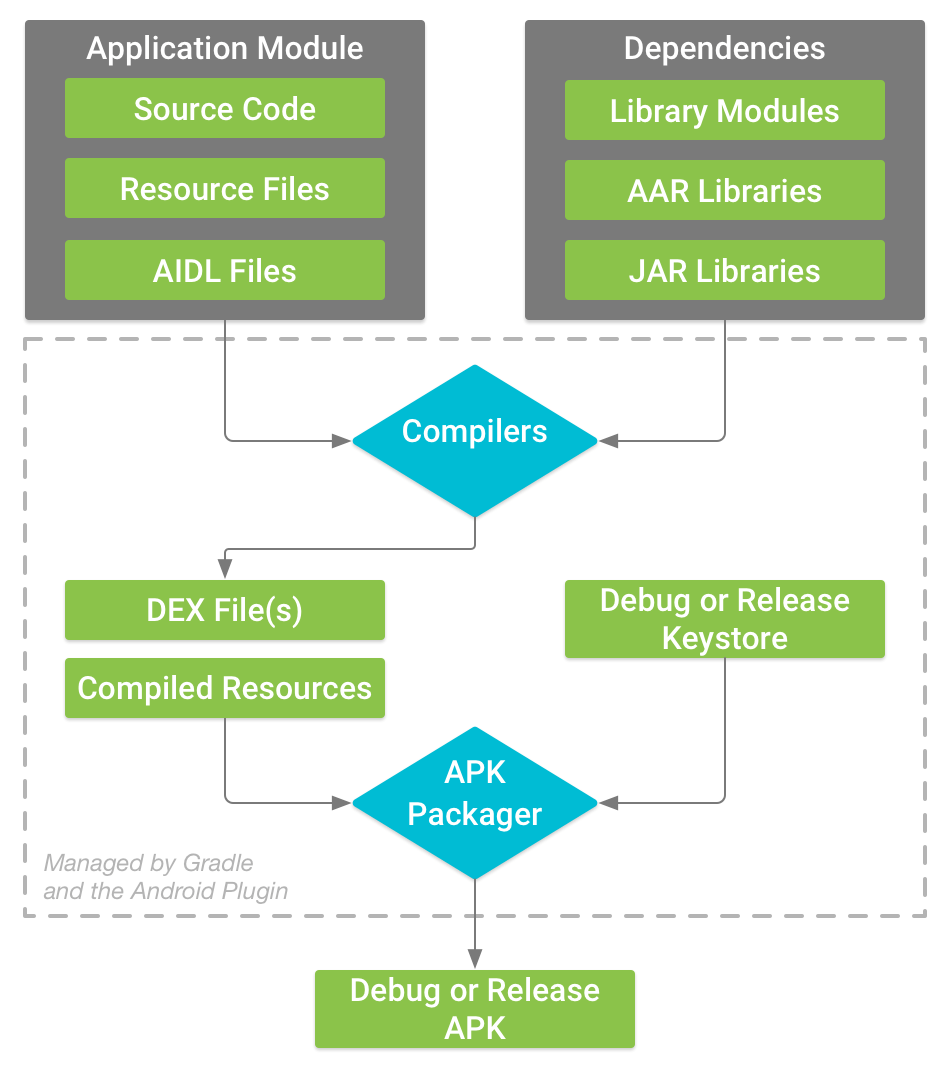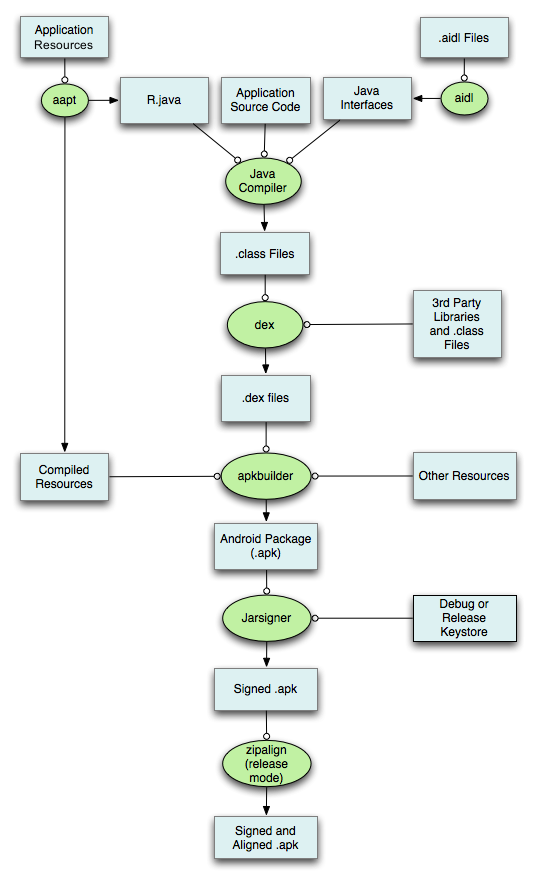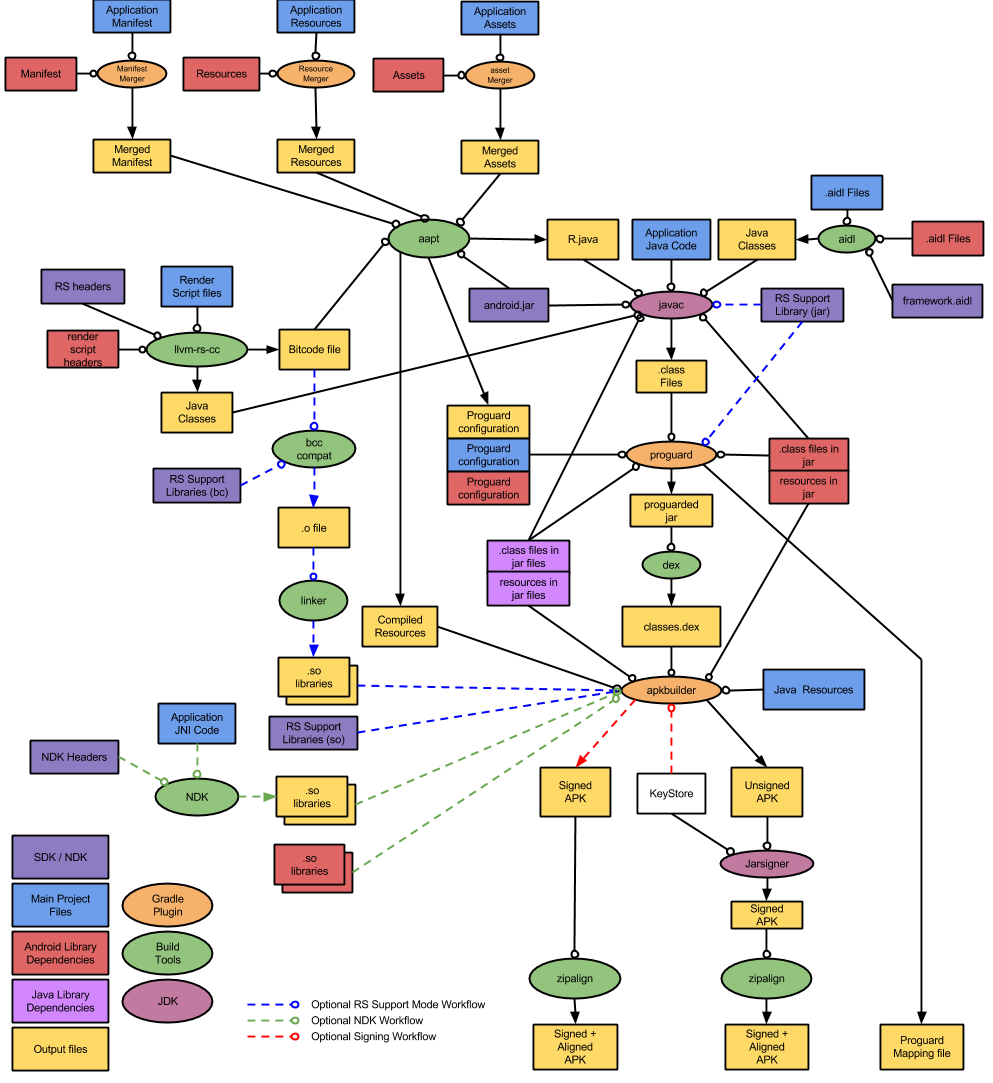You can not select more than 25 topics
Topics must start with a letter or number, can include dashes ('-') and can be up to 35 characters long.
298 lines
12 KiB
298 lines
12 KiB
---
|
|
Android APK 构建流程
|
|
---
|
|
|
|
#### 目录
|
|
|
|
1. 前言
|
|
2. 构建流程
|
|
|
|
2. Android Gradle Plugin 源码分析
|
|
|
|
#### 前言
|
|
|
|
本篇文章大量摘自 [Apk 打包流程梳理](https://juejin.im/entry/58b78d1b61ff4b006cd47e5b) 以及其文章中的参考文章,我觉得你只要把那篇文章及其参考文看完,熟悉 APK 构建流程和安装流程完全不在话下。
|
|
|
|
当然,看完文章之后,你可以试试自己画一下构建流程图。
|
|
|
|
本篇主要用来记录学习过程,再次感谢大佬们的分享精神~
|
|
|
|
#### 构建流程
|
|
|
|
先来一张 [Android 配置构建](https://developer.android.com/studio/build/index.html?hl=zh-cn#build-process) 官网上的一张图:
|
|
|
|

|
|
|
|
这个新版的图,比较好理解,就不过阐述了,我还是喜欢老版的经典构建图:
|
|
|
|

|
|
|
|
从上面的流程图,我可以看出 APK 构建流程可以分为以下七步:
|
|
|
|
1. 通过 aapt 打包 res 资源文件,生成 R.java、resources.arsc 和 res 文件(二进制和非二进制如 res/raw 和 pic 保持原样)
|
|
2. 处理 .aidl 文件,生成对应的 Java 接口文件
|
|
3. 通过 Java Compiler 编译 R.java、Java 接口文件、Java 源文件,生成 .class 文件
|
|
4. 通过 dx/d8 工具,将 .class 文件和第三方库中的 .class 文件处理生成 classes.dex
|
|
5. 通过 apkbuilder 工具,将 aapt 生成的 resources.arsc 和 res 文件、assets 文件和 classes.dex 一起打包生成 apk
|
|
6. 通过 Jarsigner 工具,对上面的 apk 进行 debug 或 release 签名
|
|
7. 通过 zipalign 工具,对签名后的 apk 进行对齐处理
|
|
|
|
##### 第一步:aapt
|
|
|
|
aapt(Android Asset Packaging Tool),用于打包资源文件,生成 R.java 和编译后的资源。aapt 的源码位于 frameworks/base/tools/aapt2 目录下。
|
|
|
|
##### 第二步:aidl
|
|
|
|
用于处理 aidl 文件,源码位于 frameworks/base/tools/aidl。输入 aidl 后缀的文件,输出可用于进程通信的 C/S 端 Java 代码,位于 build/generated/source/aidl。
|
|
|
|
##### 第三步:Java 源码编译
|
|
|
|
有了 R.java 和 aidl 生成的 Java 文件,再加上工程的源代码,现在就可以使用 javac 进行正常的 java 编译生成 class 文件了。
|
|
|
|
输入:java source 的文件夹(另外还包括了 build/generated 下的:R.java,aidl 生成的 Java 文件以及 BuildConfig.java)
|
|
|
|
输出:对于 gradle 编译,可以在 build/intermediates/classes 里,看到输出的 class 文件。
|
|
|
|
##### 第四步:dex
|
|
|
|
使用 dx/d8 工具将 class 文件转化为 dex 文件,生成常量池,消除冗余数据等。
|
|
|
|
##### 第五步:apkbuilder
|
|
|
|
打包生成 APK 文件,现在都已经通过 sdklib.jar 的 ApkBuilder 类进行打包了,输入为我们之前生成的包含 resources.arsc 的 .ap_ 文件,上一步生成的 dex 文件,以及其他资源如 jni、jar 包内的资源。
|
|
|
|
##### 第六步:Jarsigner
|
|
|
|
对 apk 文件进行签名,APK 需要签名才能在设备上进行安装。现在不仅可以使用 jarsigner,还可以使用 apksigner。
|
|
|
|
##### 第七步:zipalign
|
|
|
|
对签名后的 apk 文件进行对齐处理,使得 apk 中所有资源文件距离文件起始偏移为四个字节的整数倍,从而在通过内存映射访问 apk 文件时会更快。
|
|
|
|
需要注意的,使用不同的签名工具对对齐是有影响的。如果使用 jarsigner,则只能在 APK 文件签名后执行 zipalign;如果使用 apksigner,则只能在 APK 文件签名之前执行 zipalign。
|
|
|
|
详见官网描述:[zipalign](https://developer.android.com/studio/command-line/zipalign)
|
|
|
|
详细构建流程图:
|
|
|
|

|
|
|
|
#### Android Gradle Plugin
|
|
|
|
有了以上的初步了解之后,再来看看 Android Gradle Plugin 是如何实现构建流程的。
|
|
|
|
我们使用的 apply plugin: 'com.android.application' 和 apply plugin:'com.android.library' 插件对应的类分别是 AppPlugin 和 LibraryPlugin。它们都是继承 BasePlugin:
|
|
|
|
```java
|
|
public abstract class BasePlugin<E extends BaseExtension2> implements Plugin<Project>{
|
|
@Override
|
|
public final void apply(@NonNull Project project) {
|
|
//核心方法
|
|
basePluginApply(project);
|
|
//因为 apply 是 final
|
|
//所以提供一个 pluginSpecificApply 用于 AppPlugin 和 LibraryPlugin 加入特殊逻辑
|
|
pluginSpecificApply(project);
|
|
}
|
|
}
|
|
```
|
|
|
|
看到重写的 apply 方法是 final,就很开心了,也就是说我们只需要分析 BasePlugin 里面的逻辑就好了。核心方法是 basePluginApply,源码如下:
|
|
|
|
```java
|
|
private void basePluginApply(@NonNull Project project) {
|
|
//核心三个方法
|
|
configureProject();
|
|
configureExtension();
|
|
createTasks();
|
|
}
|
|
```
|
|
|
|
##### configureProject()
|
|
|
|
```
|
|
private void configureProject() {
|
|
//主构建器类,它提供了处理构建的所有数据,比如 DefaultProductFlavor、DefaultBuildType 以及一些依赖项,在执行的时候使用它们特定的构建步骤
|
|
AndroidBuilder androidBuilder = new AndroidBuilder();
|
|
//...
|
|
// 依赖 Java 插件
|
|
project.getPlugins().apply(JavaBasePlugin.class);
|
|
//Plugin 的全局变量
|
|
new GlobalScope()
|
|
}
|
|
```
|
|
|
|
##### configureExtension()
|
|
|
|
```java
|
|
private void configureExtension() {
|
|
ObjectFactory objectFactory = project.getObjects();
|
|
//创建 BuildType、ProductFlavor、SigningConfig、BaseVariantOutput 的容器
|
|
final NamedDomainObjectContainer<BuildType> buildTypeContainer =
|
|
project.container());
|
|
final NamedDomainObjectContainer<ProductFlavor> productFlavorContainer =
|
|
project.container());
|
|
final NamedDomainObjectContainer<SigningConfig> signingConfigContainer =
|
|
project.container());
|
|
|
|
final NamedDomainObjectContainer<BaseVariantOutput> buildOutputs =
|
|
project.container(BaseVariantOutput.class);
|
|
|
|
project.getExtensions().add("buildOutputs", buildOutputs);
|
|
|
|
sourceSetManager = new SourceSetManager();
|
|
//创建 BaseExtension
|
|
extension = createExtension();
|
|
|
|
globalScope.setExtension(extension);
|
|
|
|
variantFactory = createVariantFactory(globalScope, extension);
|
|
//创建 TaskManager
|
|
taskManager = createTaskManager();
|
|
//创建 VariantManager
|
|
variantManager = new VariantManager();
|
|
|
|
registerModels(registry, globalScope, variantManager, extension, extraModelInfo);
|
|
variantFactory.createDefaultComponents(
|
|
buildTypeContainer, productFlavorContainer, signingConfigContainer);
|
|
}
|
|
```
|
|
|
|
##### createTask()
|
|
|
|
```java
|
|
private void createTasks() {
|
|
//注册一些默认 Task,比如 uninstallAll、deviceCheck、connectedCheck 等
|
|
taskManager.createTasksBeforeEvaluate()
|
|
|
|
createAndroidTasks();
|
|
}
|
|
|
|
final void createAndroidTasks() {
|
|
//...
|
|
List<VariantScope> variantScopes = variantManager.createAndroidTasks();
|
|
}
|
|
```
|
|
|
|
然后就一直到了 TaskManager#createTasksForVariantScope 方法,它是一个抽象方法,我们看它在 ApplicationTaskManager 中的实现:
|
|
|
|
```java
|
|
public void createTasksForVariantScope(@NonNull final VariantScope variantScope) {
|
|
createAnchorTasks(variantScope);
|
|
//checkXxxManifest 检查 Manifest 文件存在、路径
|
|
createCheckManifestTask(variantScope);
|
|
|
|
handleMicroApp(variantScope);
|
|
|
|
//把依赖放到 TransformManager 中
|
|
createDependencyStreams(variantScope);
|
|
|
|
// Add a task to publish the applicationId.
|
|
createApplicationIdWriterTask(variantScope);
|
|
|
|
// 合并 manifest
|
|
createMergeApkManifestsTask(variantScope);
|
|
|
|
// Add a task to create the res values
|
|
createGenerateResValuesTask(variantScope);
|
|
|
|
// Add a task to compile renderscript files.
|
|
createRenderscriptTask(variantScope);
|
|
|
|
// 合并 resource
|
|
createMergeResourcesTask(
|
|
variantScope,
|
|
true,
|
|
Sets.immutableEnumSet(MergeResources.Flag.PROCESS_VECTOR_DRAWABLES));
|
|
|
|
// 合并 assets 文件夹
|
|
createMergeAssetsTask(variantScope);
|
|
|
|
// 生成 BuildConfig.java 文件
|
|
createBuildConfigTask(variantScope);
|
|
|
|
// Add a task to process the Android Resources and generate source files
|
|
createApkProcessResTask(variantScope);
|
|
|
|
// Add a task to process the java resources
|
|
createProcessJavaResTask(variantScope);
|
|
|
|
createAidlTask(variantScope);
|
|
|
|
// Add external native build tasks
|
|
createExternalNativeBuildJsonGenerators(variantScope);
|
|
createExternalNativeBuildTasks(variantScope);
|
|
|
|
// Add a task to merge the jni libs folders
|
|
createMergeJniLibFoldersTasks(variantScope);
|
|
|
|
// Add feature related tasks if necessary
|
|
if (variantScope.getType().isBaseModule()) {
|
|
// Base feature specific tasks.
|
|
taskFactory.register(new FeatureSetMetadataWriterTask.CreationAction(variantScope));
|
|
|
|
createValidateSigningTask(variantScope);
|
|
// Add a task to produce the signing config file.
|
|
taskFactory.register(new SigningConfigWriterTask.CreationAction(variantScope));
|
|
|
|
if (extension.getDataBinding().isEnabled()) {
|
|
// Create a task that will package the manifest ids(the R file packages) of all
|
|
// features into a file. This file's path is passed into the Data Binding annotation
|
|
// processor which uses it to known about all available features.
|
|
//
|
|
// <p>see: {@link TaskManager#setDataBindingAnnotationProcessorParams(VariantScope)}
|
|
taskFactory.register(
|
|
new DataBindingExportFeatureApplicationIdsTask.CreationAction(
|
|
variantScope));
|
|
|
|
}
|
|
} else {
|
|
// Non-base feature specific task.
|
|
// Task will produce artifacts consumed by the base feature
|
|
taskFactory.register(
|
|
new FeatureSplitDeclarationWriterTask.CreationAction(variantScope));
|
|
if (extension.getDataBinding().isEnabled()) {
|
|
// Create a task that will package necessary information about the feature into a
|
|
// file which is passed into the Data Binding annotation processor.
|
|
taskFactory.register(
|
|
new DataBindingExportFeatureInfoTask.CreationAction(variantScope));
|
|
}
|
|
taskFactory.register(new MergeConsumerProguardFilesTask.CreationAction(variantScope));
|
|
}
|
|
|
|
// Add data binding tasks if enabled
|
|
createDataBindingTasksIfNecessary(variantScope, MergeType.MERGE);
|
|
|
|
// Add a compile task
|
|
createCompileTask(variantScope);
|
|
|
|
createStripNativeLibraryTask(taskFactory, variantScope);
|
|
|
|
|
|
if (variantScope.getVariantData().getMultiOutputPolicy().equals(MultiOutputPolicy.SPLITS)) {
|
|
if (extension.getBuildToolsRevision().getMajor() < 21) {
|
|
throw new RuntimeException(
|
|
"Pure splits can only be used with buildtools 21 and later");
|
|
}
|
|
|
|
createSplitTasks(variantScope);
|
|
}
|
|
|
|
|
|
TaskProvider<BuildInfoWriterTask> buildInfoWriterTask =
|
|
createInstantRunPackagingTasks(variantScope);
|
|
createPackagingTask(variantScope, buildInfoWriterTask);
|
|
|
|
// Create the lint tasks, if enabled
|
|
createLintTasks(variantScope);
|
|
|
|
taskFactory.register(new FeatureSplitTransitiveDepsWriterTask.CreationAction(variantScope));
|
|
|
|
createDynamicBundleTask(variantScope);
|
|
}
|
|
```
|
|
|
|
#### 参考
|
|
|
|
[Apk 打包流程梳理](https://juejin.im/entry/58b78d1b61ff4b006cd47e5b)
|
|
|
|
[Android App 编译流程详解](https://gitbook.cn/gitchat/activity/5cb3f38f6f093c03b1bfe0f5) |